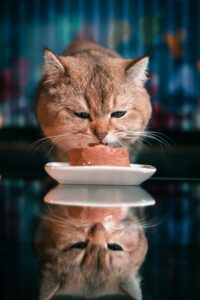Mastering Cat Food Labels: Essential Insights for Health-Conscious Pet Owners
Learning to read cat food labels is not just a minor task; it is a critical skill that every responsible pet owner should cultivate. This knowledge is key to ensuring that your beloved feline receives the appropriate nutritional balance crucial for their overall health. Cat food labels provide an array of important information that goes far beyond the surface-level text on packaging. They serve as a detailed guide to the quality, ingredients, and composition of your cat’s diet. By familiarizing yourself with these labels, you gain the ability to make well-informed choices that can greatly improve your cat’s vitality, health, and longevity.
One of the most important aspects of cat food labels is the specialized terminology used. For example, phrases like “complete and balanced” indicate that the product adheres to the nutritional standards set by the Association of American Feed Control Officials (AAFCO). Understanding these terms equips you to choose foods that offer the essential nutrients your cat needs for optimal health. This knowledge empowers you to tailor your cat’s diet to meet their individual health needs, ensuring they thrive.
When exploring cat food packaging, you will often encounter terms like ‘natural’ or ‘organic’. While these labels catch the eye of consumers, they have specific definitions that imply varying levels of quality. ‘Natural’ generally means that the food is free from artificial flavors and colors, but it does not guarantee superior nutritional quality. In contrast, ‘organic’ refers to specific farming practices that typically yield a higher standard of safety and quality. This makes organic options a more favorable choice for health-conscious pet owners committed to providing the best for their furry companions.
The AAFCO plays a crucial role in setting nutritional guidelines within the pet food industry. Their standards ensure that products labeled as ‘complete and balanced’ meet specific nutritional requirements tailored to the various life stages of cats. Understanding the implications of these labels is vital for pet owners striving to make informed dietary choices for their cats. Armed with this knowledge, you can confidently select food options that are perfectly suited to meet your cat’s unique dietary requirements and health concerns.
Having a comprehensive understanding of what appears on your cat’s food label can significantly enhance your ability to make nutritious selections that support their overall health and well-being. The insights you gain will empower you to choose high-quality food options that align with your cat’s specific dietary needs, thus ensuring they lead a happy and healthy life.
 Deciphering Cat Food Ingredients: Essential Insights for Healthier Choices
Deciphering Cat Food Ingredients: Essential Insights for Healthier Choices
A fundamental aspect of understanding cat food labels is meticulously examining the ingredients list. Ingredients are usually listed in descending order of weight before cooking, which means the first few items indicate the primary components of the food. This hierarchy is essential because it provides significant insights into what your cat consumes daily, ultimately influencing their health and vitality.
As obligate carnivores, cats require that protein sources dominate the ingredient list. Look for explicit protein sources such as chicken, beef, or salmon at the top of the list instead of vague terms like ‘meat meal’. This specificity not only suggests a higher quality diet but also aligns with your cat’s natural dietary preferences and nutritional needs, which is crucial for promoting their overall well-being.
Furthermore, it’s vital to identify and minimize certain additives and fillers present in your cat’s food. Ingredients like corn, soy, or wheat gluten may enhance the food’s bulk but provide little in terms of nutritional benefits for your feline friend. Instead, opt for food that incorporates whole grains and wholesome vegetables, which can serve as healthier alternatives and contribute to a more balanced diet that actively supports your cat’s health.
Be cautious about artificial preservatives commonly found in pet foods, such as BHA, BHT, and ethoxyquin. Although these substances are often used to prolong shelf life, they might not be the healthiest choices for your furry companion. Instead, opt for foods that utilize natural preservatives like vitamin E (tocopherols) or vitamin C (ascorbyl palmitate) to ensure your cat enjoys a quality diet that supports their health.
If you encounter unfamiliar or lengthy ingredient names, take the time to research them. Being informed about what goes into your cat’s food is the best way to make educated choices that contribute to their overall health and happiness.
Assessing Nutritional Content: Crafting the Ideal Diet for Your Cat’s Health
Understanding the Guaranteed Analysis section on cat food labels is vital for gaining insights into the nutrient composition of the food. This section typically outlines the minimum or maximum percentages of crude protein, fat, fiber, and moisture. Achieving the right balance of these nutrients is crucial for maintaining your cat’s overall health and well-being.
When selecting cat food, protein content should be a primary consideration. Cats thrive on high levels of protein, making it essential to ensure that adequate amounts come from animal sources, which provide the essential amino acids necessary for optimal functioning. Avoid foods that heavily feature plant-based proteins, as these often lack the complete range of nutrients vital for your cat’s health.
Carbohydrate content is also a significant factor in your cat’s diet. While some carbohydrates can be beneficial in moderation, they should not dominate the ingredient list, particularly for cats that may be prone to weight gain. Look for foods that focus on higher protein and lower carbohydrate levels to support a healthy and balanced diet tailored to your cat’s specific needs.
Essential nutrients, such as taurine, are critical for your cat’s health. Taurine plays a vital role in maintaining heart and eye health, and since cats cannot produce it on their own, it’s crucial to ensure that your chosen food includes this essential component. Always check the label to confirm that taurine is present in the food you select to support your cat’s well-being.
Be vigilant about potential allergic reactions in cats that may arise from specific food ingredients or dietary imbalances. Allergens can vary greatly among cats, so closely monitoring your pet for any adverse reactions is essential. If necessary, consider exploring hypoallergenic food options designed specifically for sensitive cats to ensure their overall well-being and health.
 Essential Tips for Selecting the Best Cat Food to Boost Your Cat’s Health
Essential Tips for Selecting the Best Cat Food to Boost Your Cat’s Health
Choosing the right food for your cat requires more than simply selecting the product with the most eye-catching packaging. It involves aligning the nutritional content with your cat’s individual needs and lifestyle. When making your selection, consider crucial factors such as your cat’s age, activity level, and any specific health conditions they may have that could influence their dietary requirements.
Customizing your cat’s diet to align with their lifestyle can significantly impact their health and vitality. For example, an energetic outdoor cat typically needs more calories and protein compared to a less active indoor cat. Understanding your cat’s daily activities can guide you in providing a diet that meets their specific energy needs, ensuring they remain healthy and active.
Keep in mind that price does not always equal quality; therefore, avoid being influenced by cost alone. Sometimes, you might pay a premium for branding rather than actual nutritional benefits. Understanding the importance of the ingredients and nutritional content is far more critical than the price tag when it comes to your cat’s health and well-being.
Be aware that pet food brands frequently modify their recipes, sometimes subtly and at other times significantly. Staying informed about these changes ensures that you are always aware of what is being served in your cat’s bowl. Regularly checking for updates from brands can help you avoid unexpected dietary changes that could adversely affect your cat’s health.
Lastly, seeking advice from your veterinarian can provide tailored insights specific to your cat’s health needs. A veterinarian can recommend appropriate food options that accommodate dietary restrictions or health concerns, giving you peace of mind that your cat is receiving the optimal nutrition necessary for a happy and healthy life.
The Article : How To Interpret Your Cat’s Food Labels Appeared First On Unity Pets.
The Article Interpreting Cat Food Labels: A Quick Guide Was Found On https://limitsofstrategy.com
The Article Cat Food Labels: Quick Guide to Understanding Them First Appeared ON
: https://ad4sc.com
Comments are closed